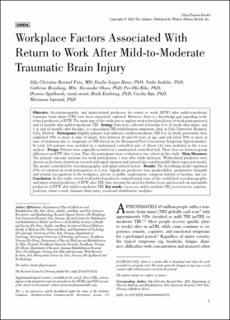| dc.contributor.author | Fure, Silje Christine Reistad | |
| dc.contributor.author | Howe, Emilie | |
| dc.contributor.author | Andelic, Nada | |
| dc.contributor.author | Brunborg, Cathrine | |
| dc.contributor.author | Olsen, Alexander | |
| dc.contributor.author | Rike, Per-Ola | |
| dc.contributor.author | Spjelkavik, Øystein | |
| dc.contributor.author | Enehaug, Heidi | |
| dc.contributor.author | Røe, Cecilie | |
| dc.contributor.author | Løvstad, Marianne | |
| dc.date.accessioned | 2022-08-23T07:40:00Z | |
| dc.date.available | 2022-08-23T07:40:00Z | |
| dc.date.created | 2022-04-12T08:28:06Z | |
| dc.date.issued | 2022-03-15 | |
| dc.identifier.issn | 0885-9701 | |
| dc.identifier.uri | https://hdl.handle.net/11250/3013001 | |
| dc.description.abstract | Objective: Sociodemographic and injury-related predictors for return to work (RTW) after mild-to-moderate traumatic brain injury (TBI) have been extensively explored. However, there is a knowledge gap regarding work-related predictors of RTW. The main aim of this study was to explore work-related predictors of work participation 6 and 12 months after mild-to-moderate TBI.
Setting: Data were collected at baseline 8 to 12 weeks after injury, and 3, 6, and 12 months after baseline, at a specialized TBI rehabilitation outpatient clinic at Oslo University Hospital, Oslo, Norway.
Participants: Eligible patients had suffered a mild-to-moderate TBI 8 to 12 weeks previously, were employed 50% or more at time of injury, were between 18 and 60 years of age, and sick listed 50% or more at time of inclusion due to symptoms of TBI (based on the Rivermead Post-Concussion Symptoms Questionnaire). In total, 116 patients were included in a randomized controlled trial, of whom 113 were included in the 1-year analysis.
Design: Patients were originally included in a randomized controlled trial. There were no between-group differences in RTW after 1 year. Thus, the participants were evaluated as one cohort in this study.
Main Measures: The primary outcome measure was work participation 1 year after study inclusion. Work-related predictors were chosen on the basis of previous research and expert opinion and entered into a multivariable linear regression model. The model controlled for sociodemographic and injury-related factors.
Results: The best-fitting model explained 25% of variation in work participation at 1 year. Significant predictors were predictability, quantitative demands and rewards (recognition) at the workplace, private or public employment, symptom burden at baseline, and sex.
Conclusion: In this study, several work-related predictors outperformed some of the established sociodemographic and injury-related predictors of RTW after TBI, thus stressing the need for further focus and research on amendable predictors of RTW after mild-to-moderate TBI. | en_US |
| dc.language.iso | eng | en_US |
| dc.publisher | Lippincott, Williams & Wilkins | en_US |
| dc.relation.ispartofseries | The journal of head trauma rehabilitation; | |
| dc.rights | Attribution-NonCommercial-NoDerivatives 4.0 Internasjonal | * |
| dc.rights.uri | http://creativecommons.org/licenses/by-nc-nd/4.0/deed.no | * |
| dc.subject | Concussions | en_US |
| dc.subject | Mild-to-moderate traumatic brain injuries | en_US |
| dc.subject | Postconcussion symptoms | en_US |
| dc.subject | Predictions | en_US |
| dc.subject | Return to work | en_US |
| dc.subject | Vocational rehabilitation | en_US |
| dc.subject | Workplaces | en_US |
| dc.title | Workplace Factors Associated With Return to Work After Mild-to-Moderate Traumatic Brain Injury | en_US |
| dc.type | Peer reviewed | en_US |
| dc.type | Journal article | en_US |
| dc.description.version | publishedVersion | en_US |
| cristin.ispublished | true | |
| cristin.fulltext | original | |
| cristin.qualitycode | 1 | |
| dc.identifier.doi | https://doi.org/10.1097/HTR.0000000000000772 | |
| dc.identifier.cristin | 2016882 | |
| dc.source.journal | The journal of head trauma rehabilitation | en_US |
| dc.source.pagenumber | 1-9 | en_US |
| dc.relation.project | Norges forskningsråd: 272789 | en_US |
| dc.relation.project | Norges forskningsråd: 256689 | en_US |

